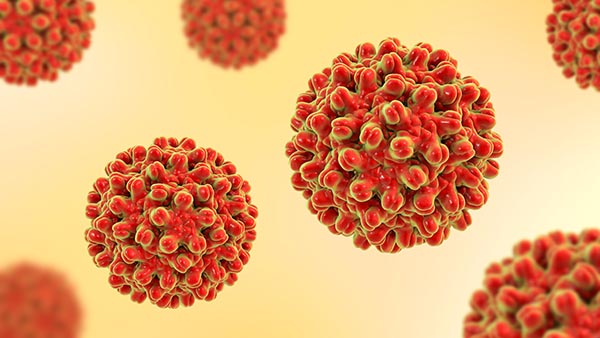Johnson & Johnson’s Janssen Pharmaceuticals will partner with Arrowhead Pharmaceuticals to develop an RNA interference (RNAi) treatment candidate for hepatitis B virus (HBV), plus up to three other RNAi therapies against targets to be selected by Janssen, through a collaboration Arrowhead said could generate for it more than $3.7 billion.
The companies’ license and collaboration agreement gives Janssen a global exclusive license to Arrowhead’s ARO-HBV program, designed to develop a third-generation subcutaneously administered RNAi therapeutic candidate as a potentially curative therapy for patients with chronic HBV.
Just last month at the 18th World Gastroenterologists Summit in Auckland, New Zealand, Arrowhead presented the first clinical data from the lowest two dose cohorts (100mg and 200mg in the ongoing Phase I/II AROHBV1001 trial (NCT03365947), designed to assess the safety, tolerability, pharmacokinetics, and pharmacodynamics of single- and multiple-ascending doses of ARO-HBV in healthy adult volunteers and participants with HBV.
Arrowhead trumpeted the positive early results: Three monthly doses of ARO-HBV led to a maximum reduction in circulating HBV surface antigen (HBsAg) of 4.0 log10 (99.99%), with mean reductions of approximately 2.0 log10 (99%) on day 85 in the 100 mg cohort and 1.4 log10 (96%) on day 71 in the 200mg cohort.
All eight patients achieved greater than 1.0 log10 reductions in circulating HBsAg, the company said, with a minimum HBsAg reduction in all patients from both dose cohorts of 1.2 log10 (93%).
“These initial results from the first two multiple-ascending dose cohorts of the AROHBV1001 clinical study are encouraging and indicate that ARO-HBV is highly active,” Bruce Given, M.D., Arrowhead’s COO and head of R&D, said in a September 6 statement.
Beyond the AROHBV1001 trial, Janssen agreed to be wholly responsible for clinical development and commercialization of ARO-HBV, Arrowhead said.
Applying TRiM™ Platform
Under their collaboration, Janssen agreed to select up to three new targets, against which Arrowhead will develop clinical candidates. The companies did not specify the therapeutic areas for those targets, except to say the resulting potential treatment candidates will apply Arrowhead’s proprietary Targeted RNAi Molecule (TRiM™) platform, and do not include Arrowhead’s current pipeline.
According to Arrowhead, the TRiM platform consists of a “highly-potent” RNA trigger with the following components optimized, as needed, for each drug candidate: a high affinity targeting ligand; various linker and chemistries; structures that enhance pharmacokinetics; and highly potent RNAi triggers with sequence specific stabilization chemistries. TRiM is designed to enable tissue-specific targeting while being structurally simple, through the use of ligand-mediated delivery.
Arrowhead asserts that therapeutics developed with the TRiM platform offer simplified manufacturing and reduced costs; multiple routes of administration; potential for improved safety due to reduced risk of intracellular buildup because of fewer metabolites from smaller molecules.
TRiM-platform therapeutics offer another advantage, Arrowhead adds, the potential for developing treatments against targets beyond the liver, including the lungs and tumors.
“The collaboration also represents further validation of the TRiM platform and provides an important opportunity to create up to three additional novel medicines by leveraging Arrowhead’s speed and expertise in RNAi drug discovery and Janssen’s clinical development and commercial capabilities,” Christopher Anzalone, Ph.D., Arrowhead’s president and CEO, said in a statement.
For the three additional targets, Arrowhead said, it agreed to carry out discovery, optimization, and preclinical development, entirely funded by Janssen, to enable the filing of an IND with the FDA, at which time Janssen will have the option to take an exclusive license.
Should Janssen exercise that option, it will be wholly responsible for clinical development and commercialization, Arrowhead added.
‘Important Next Step’
Beyond ARO-HBV, Arrowhead’s pipeline includes two Phase I candidates: ARO-AAT for liver disease associated with alpha-1 antitrypsin deficiency, being wholly developed by Arrowhead; and AMG 890 (also called ARO-LPA), a cardiovascular disease candidate for which Amgen inked a worldwide, exclusive license in a potentially $673 million-plus deal with Amgen in 2016.
On August 1, Arrowhead disclosed that it had earned a $10 million milestone payment from Amgen following the administration of the first dose of AMG 890 in a Phase I trial (NCT03626662) assessing the safety, tolerability, pharmacokinetics, and pharmacodynamic effects of the treatment in patients with elevated plasma Lipoprotein(a).
Janssen has agreed to pay Arrowhead $175 million as an upfront payment, while J&J’s venture capital subsidiary, Johnson & Johnson Innovation-JJDC, agreed to make a $75 million equity investment in Arrowhead at a price of $23 per share of Arrowhead common stock—about 24% above yesterday’s closing price for Arrowhead shares of $18.56.
Arrowhead is eligible to receive:
- Up to approximately $1.6 billion in payments tied to achieving milestones for the HBV license agreement, including a $50 million milestone payment linked to a Phase II study.
- Approximately $1.9 billion in option and milestone payments for the collaboration agreement related to the up-to-three additional targets.
- Tiered royalties up to mid-teens on product sales.
“This agreement represents an important next step for ARO-HBV,” Dr. Anzalone added. “Arrowhead has established a leadership position in the field over the past several years, and Janssen’s proven development capabilities, global commercial reach, and commitment to HBV make it the ideal partner to potentially accelerate our goal of bringing a functional cure to patients with chronic HBV.”



